Research on the Application of CGAN in the Design of Historic Building Facades in Urban Renewal—Taking Fujian Putian Historic Districts as an Example
Abstract
1. Introduction
1.1. Research Background
1.2. Literature Review
1.3. Problem Statement and Objectives
- (1)
- Use CGAN to quickly identify, decompose, analyze, test, and evaluate the style attributes of the elements in the building facade images in the historic district;
- (2)
- Independently generate facade schemes and realize accurate, rapid, and large-scale architectural facade stylization;
- (3)
- Explore the effectiveness of CGAN in the renewal design of historic districts.
2. Materials and Research Strategy
2.1. Study Area
2.2. Methodology
- (i)
- Building Exterior Profile (BEP): this shows the outline of the building, including elements such as the facade and roof of the building;
- (ii)
- Label images of functional facade elements (Facial Semantic Labeling, FSL): mark various functional elements in building facades, including doors, windows, walls, columns, railings, and eaves, as well as their positions and sizes;
- (iii)
- The final effect of the building facade (Building Exterior, BE): this aspect presents the final effect of the building facade, which can include elements such as color, texture, and details. Through this classification method, it can be prepared for the subsequent model training so that the model can more accurately analyze and identify the building facades of the historic district of Putian, Fujian.
2.3. Material Handling
2.4. CGAN Model
3. Results
3.1. Model Evaluation
- (1)
- G_GAN is the generator’s confrontation loss, which measures how similar the image the generator generated and the real image are;
- (2)
- G_GAN_Feat is the feature matching LOSS of the generator, which can help the generator generate more high-level features, such as texture and color, to make the generated image more realistic;
- (3)
- G_VCG is a visual consistency LOSS, which forces the generator to generate images with visual consistency, that is, the similarity of each pixel in the image space;
- (4)
- D_real and D_fake are the losses of the discriminator; D_real represents the probability that the real image is recognized as a real image by the discriminator, and D_fake represents the probability that the generated image is recognized as a fake by the discriminator.
3.2. Model Testing
3.3. Model Comparison
- (1)
- We adopted a more detailed training plan and divided the entire training process into three stages: the pre-training period, the simulated annealing period, and the stabilization period. In the pre-training period, the model was preheated with a small learning rate (0.0001) in the first 40 epochs of training so that the model could learn the characteristics of the data as soon as possible. In the simulated annealing period, the model was trained from the 41st epoch to the 150th epoch, and the learning rate was gradually increased (the upper limit is 0.001). The process of simulating the gradual heating up of the model helps the model find a better solution in a wider search space. In the stable period, the learning rate of the model was gradually reduced from the 151st epoch to the 200th epoch of training (the lower limit is 0.00005) so that the model could converge more stably and prevent overfitting.
- (2)
- We adopted a learning rate decay strategy that uses cosine annealing to decay the learning rate. Specifically, the learning rate slowly decreased during the last 25% of training. Then, with the help of the cosine function, the learning rate gradually decayed to a smaller value (the decay rate of the cosine function was 0.5). In addition, techniques such as batch normalization (batch size 32) and dropout (probability 0.5) were used in this study to prevent overfitting.
- (3)
- In this study, the training data were screened and expanded to increase their diversity and quantity, which helps to improve the generalization ability and robustness of the model.
4. Discussion: Application of Model and Design of Historic District Scheme
4.1. Model Application
4.2. Application of Multi-Scheme Generation
5. Conclusions
- (1)
- For the facade decoration of historic buildings in Putian, Fujian, which is full of regional characteristics in this study, CGAN demonstrated great comprehension ability and computing potential and completed the classification, analysis, and style reconstruction of facade decoration elements. These results demonstrate that CGAN is effective for element processing in building facade images.
- (2)
- The resulting images independently generated by CGAN were similar to the real image, which shows that CGAN can batch and uniformly process the stylization of historical building facades and helps to guide the aesthetics of architectural facade decoration styles in historical districts.
- (3)
- CGAN is able to extract unspecified facade decoration styles using the provided image dataset and transplant them to new buildings through the style transfer capability, showing good results. This will help designers provide more choices in the decision-making of facade decoration style and can play a role in correcting some subjective judgments.
Author Contributions
Funding
Institutional Review Board Statement
Informed Consent Statement
Data Availability Statement
Conflicts of Interest
Appendix A
References
- Editorial Team of the Ministry of Housing and Urban-Rural Development. Beautiful Urban and Rural Housing in China; China Urban Publishing House: Beijing, China, 2022; p. 303. [Google Scholar]
- Yu, Q.; Malaeb, J.; Ma, W. Architectural facade recognition and generation through generative adversarial networks. In Proceedings of the 2020 International Conference on Big Data & Artificial Intelligence & Software Engineering (ICBASE), Bangkok, Thailand, 30 October–1 November 2020. [Google Scholar] [CrossRef]
- Sun, C.; Zhou, Y.; Han, Y. Automatic generation of architecture facade for historical urban renovation using generative adversarial network. Build. Environ. 2022, 212, 108781. [Google Scholar] [CrossRef]
- Zhang, Y. Discussion on the implementation mode of protection and renovation of historical and cultural blocks. World Archit. 2022, 12, 73–77. [Google Scholar] [CrossRef]
- Lucchi, E.; Buda, A. Urban green rating systems: Insights for balancing sustainable principles and heritage conservation for neighbourhood and cities renovation planning. Renew. Sustain. Energy Rev. 2022, 161, 112324. [Google Scholar] [CrossRef]
- Abastante, F.; Lami, I.M.; Mecca, B. How to revitalise a historic district: A stakeholders-oriented assessment framework of adaptive reuse. In Values and Functions for Future Cities; Springer: Berlin/Heidelberg, Germany, 2020; pp. 3–20. [Google Scholar]
- Zhu, Z. Protection and Improvement Planning of Tunxi Old Street. Archit. J. 1996, 9, 10–14. [Google Scholar]
- Zhang, Y.; He, Y. “Between Breaking and Building”: An Open Study of the Space of Historic Cities:A Case Study of Shuyuan Block in the Ancient City of Pingyao. Mod. Urban Stud. 2020, 7, 110–115. Available online: http://202.203.193.150/article/detail.aspx?id=7103055410 (accessed on 5 June 2023).
- Ruan, Y.; Shao, Y. The Characteristics and Protection of Ancient Towns in the South of the Yangtze River. J. Tongji Univ. Soc. Sci. Ed. 1996, 21–28. Available online: http://www.cqvip.com/qk/83262x/199601/1002507714.html (accessed on 5 June 2023).
- Lin, Z. The Evolution of Space, Imagery and Inner Spirit of China’s Coastal Cities—Reflections on the Changes of “Three Lanes and Seven Alleys” in Historic Districts. Southeast Acad. 2020, 6, 58–65. [Google Scholar]
- Yuan, Y.; Lu, Y. A Syntactic Study on the Spatial Pattern Evolution of Historic Commercial Blocks—A Case Study of Zhongshan Road in Xiamen. Planner 2013, 57–60. Available online: http://www.cqvip.com/qk/81000x/20130s2/1005562007.html (accessed on 5 June 2023).
- Goodfellow, I.; Pouget-Abadie, J.; Mirza, M.; Xu, B.; Warde-Farley, D.; Ozair, S.; Courville, A.; Bengio, Y. Generative adversarial networks. Commun. ACM 2020, 63, 139–144. [Google Scholar] [CrossRef]
- Deng, L. Deep learning: Methods and applications. Found. Trends Signal Process. 2014, 7, 197–387. [Google Scholar] [CrossRef]
- Isola, P.; Zhu, J.-Y.; Zhou, T.; Efros, A.A. Image-to-image translation with conditional adversarial networks. In Proceedings of the 2017 IEEE Conference on Computer Vision and Pattern Recognition (CVPR), Honolulu, HI, USA, 21–26 July 2017. [Google Scholar] [CrossRef]
- Chen, Y.; Wei, G. Application Review of Generative Adversarial Networks. J. Tongji Univ. Nat. Sci. Ed. 2020, 48, 591–601. [Google Scholar]
- Duan, Y.; Zhao, J.; He, L. Text-to-image generation algorithm based on generative adversarial networks. Comput. Syst. Appl. 2023, 32, 348–357. [Google Scholar] [CrossRef]
- Karras, T.; Laine, S.; Aila, T. A style-based generator architecture for generative adversarial networks. IEEE Trans. Pattern Anal. Mach. Intell. 2021, 43, 4217–4228. [Google Scholar] [CrossRef] [PubMed]
- Navarro-Mateu, D.; Carrasco, O.; Cortes Nieves, P. Color-patterns to architecture conversion through conditional generative adversarial networks. Biomimetics 2021, 6, 16. [Google Scholar] [CrossRef]
- Chen, W.; Ahmed, F. PaDGAN: Learning to generate high-quality novel designs. J. Mech. Des. 2020, 143, 031703. [Google Scholar] [CrossRef]
- Xiong, Y.; Guo, S.; Chen, J.; Deng, X.; Sun, L.; Zheng, X.; Xu, W. Improved srgan for remote sensing image super-resolution across locations and sensors. Remote Sens. 2020, 12, 1263. [Google Scholar] [CrossRef]
- Ji, W.; Guo, J.; Li, Y. Multi-head mutual-attention cyclegan for unpaired image-to-image translation. IET Image Process. 2020, 14, 2395–2402. [Google Scholar] [CrossRef]
- Mostafavi, F.; Tahsildoost, M.; Zomorodian, Z.S.; Shahrestani, S.S. An interactive assessment framework for residential space layouts using pix2pix predictive model at the early-stage building design. Smart Sustain. Built Environ. 2022. [Google Scholar] [CrossRef]
- Lin, J.; Dong, Z. Application Research of Image-to-Image Generative Adversarial Network in Urban Texture Generation. In Proceedings of the 2022 National Symposium on Teaching and Research of Architectural Digital Technology in Schools of Architecture, Xiamen, China, 3 December 2022; pp. 619–624. [Google Scholar] [CrossRef]
- Kim, S.; Park, S.; Kim, H.; Yu, K. Deep floor plan analysis for complicated drawings based on style transfer. J. Comput. Civ. Eng. 2021, 35, 04020066. [Google Scholar] [CrossRef]
- Karadag, I.; Güzelci, O.Z.; Alaçam, S. EDU-ai: A twofold machine learning model to support classroom layout generation. Constr. Innov. 2022. [Google Scholar] [CrossRef]
- Meng, S.; Xu, X. Building Plane Image Generation and Latent Space Exploration Based on Generative Adversarial Network. Chin. Build. Decor. 2022, 12, 87–92. [Google Scholar]
- Newton, D. Deep generative learning for the generation and analysis of architectural plans with small datasets. Blucher Des. Proc. 2019. [Google Scholar] [CrossRef]
- Chen, K.; Lei, S.; Dai, W.; Wang, C.; Liu, A.; Li, M. Terrain reconstruction method based on open source data and conditional generative adversarial network. J. Geoinf. Sci. 2023, 25, 252–264. [Google Scholar] [CrossRef]
- Gan, Y.; Ji, Y.; Jiang, S.; Liu, X.; Feng, Z.; Li, Y.; Liu, Y. Integrating aesthetic and emotional preferences in social robot design: An affective design approach with kansei engineering and deep convolutional generative adversarial network. Int. J. Ind. Ergon. 2021, 83, 103128. [Google Scholar] [CrossRef]
- Xin, Y.X.; Zhu, F.T.; Shi, P.F.; Yang, X.; Zhou, R.K. Image super-resolution reconstruction algorithm based on improved enhanced super-resolution generative adversarial network. Laser Optoelectron. Prog. 2022, 59, 0420002. [Google Scholar]
- Garozzo, R.; Santagati, C.; Spampinato, C.; Vecchio, G. Knowledge-based generative adversarial networks for scene understanding in cultural heritage. J. Archaeol. Sci. Rep. 2021, 35, 102736. [Google Scholar] [CrossRef]
- Zhang, L.; Zheng, L.; Chen, Y.; Huang, L.; Zhou, S. CGAN-assisted renovation of the styles and features of street facades—A case study of the wuyi area in fujian, china. Sustainability 2022, 14, 16575. [Google Scholar] [CrossRef]
- Wang, H.; Yang, J.; Wu, Z.; Zhang, Y. Research on street style generation method based on residents’ preference from the perspective of machine learning. New Archit. 2022, 06, 19–24. [Google Scholar] [CrossRef]
- As, I.; Pal, S.; Basu, P. Artificial intelligence in architecture: Generating conceptual design via deep learning. Int. J. Archit. Comput. 2018, 16, 306–327. [Google Scholar] [CrossRef]
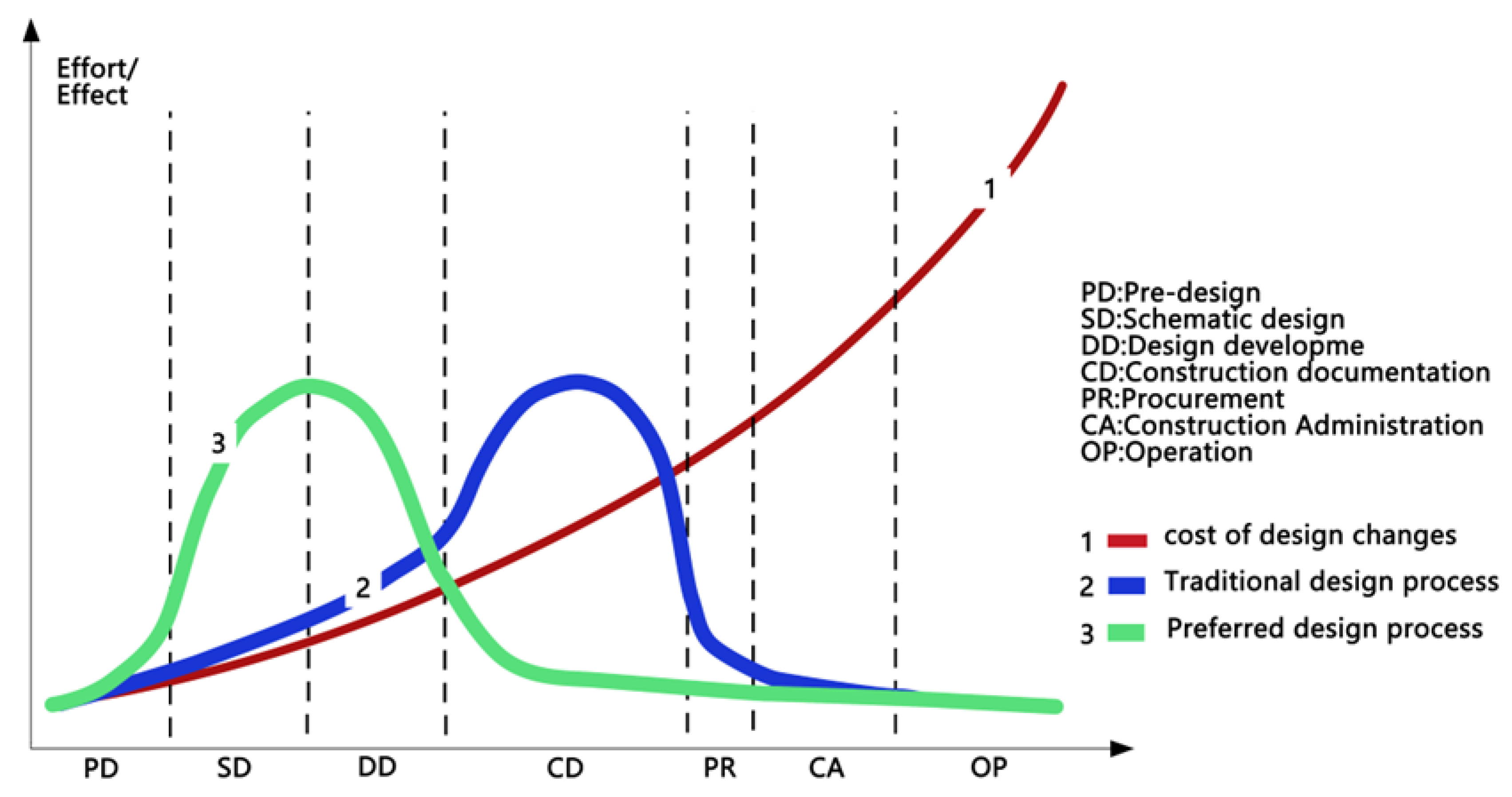
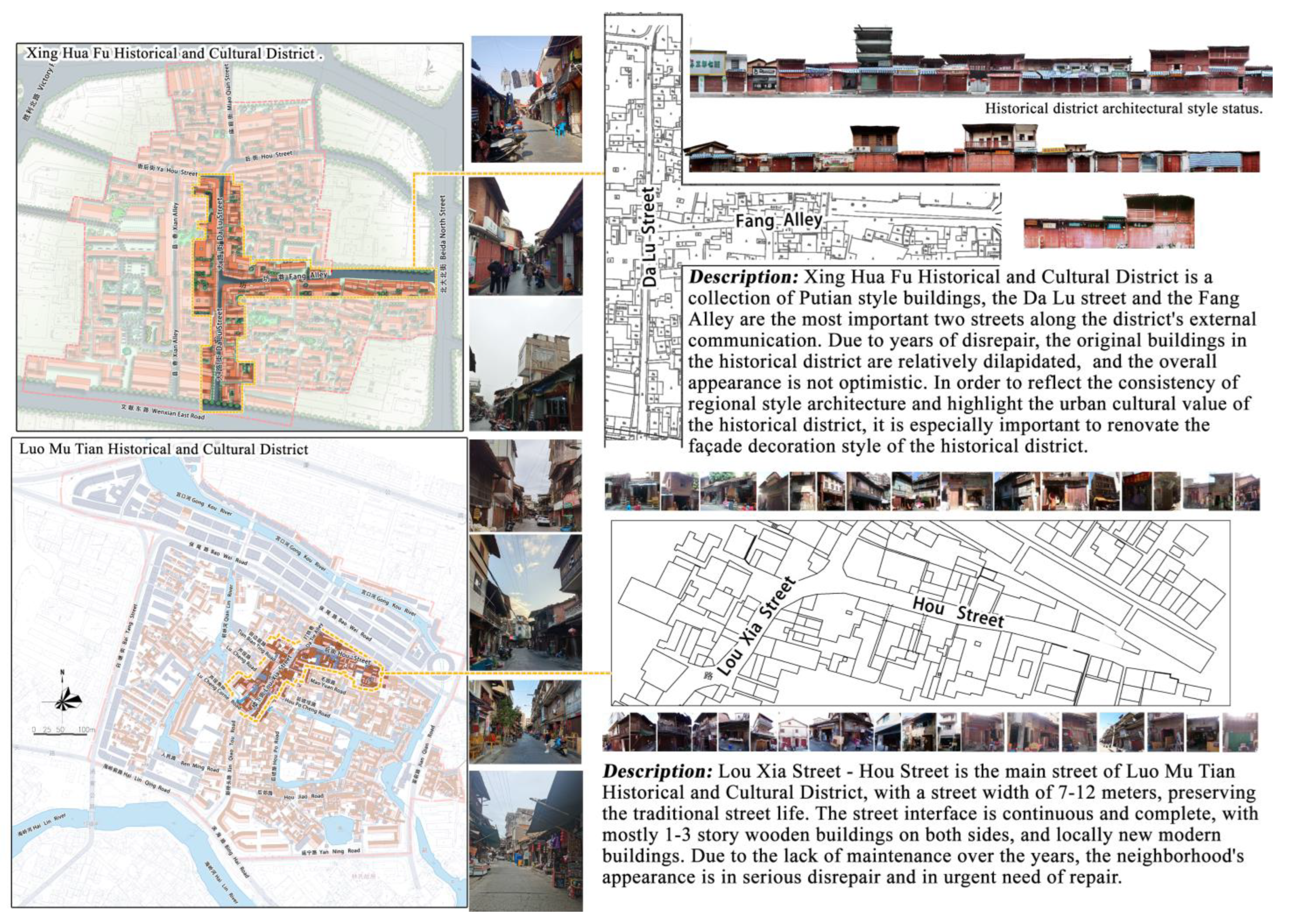
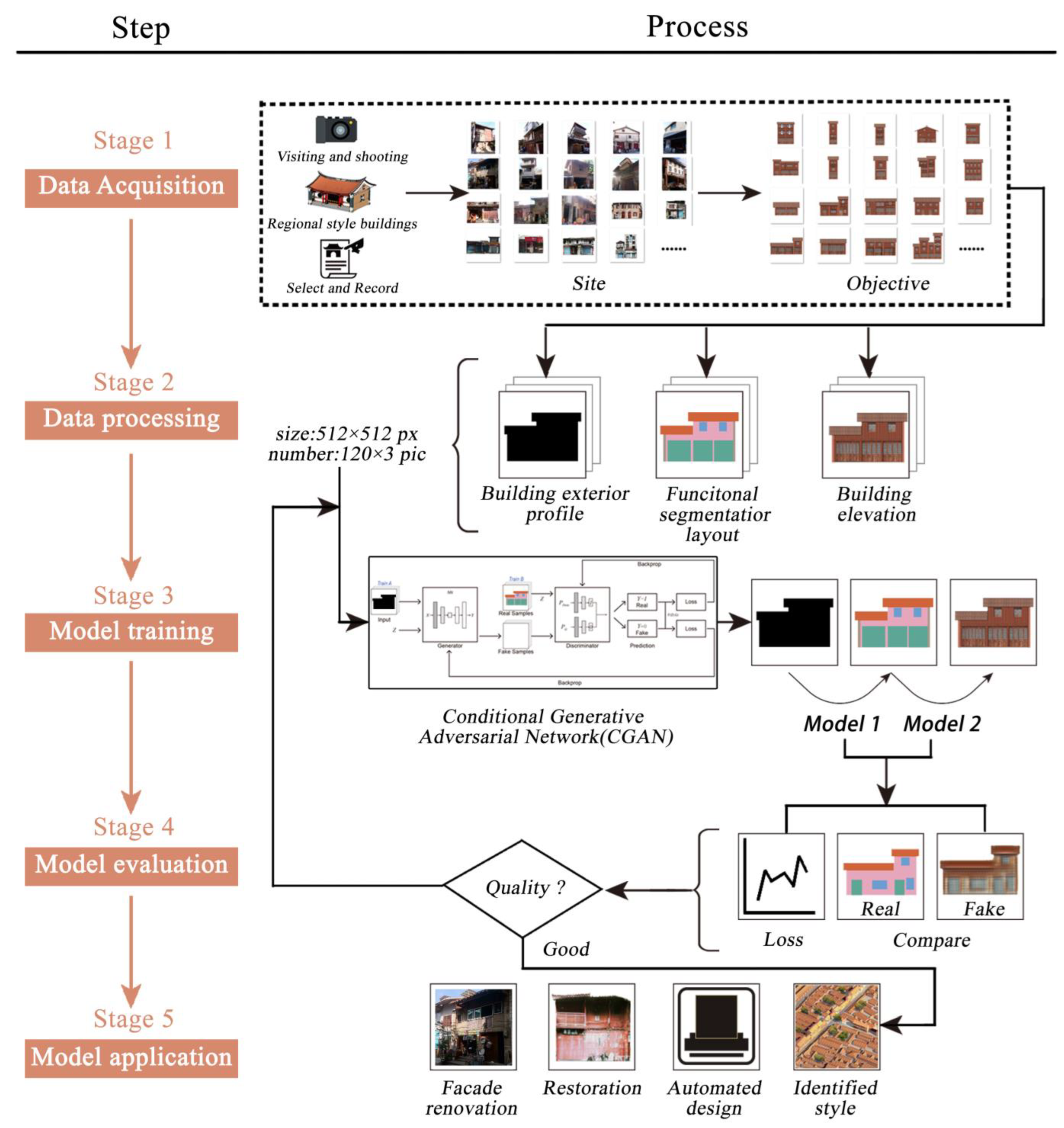
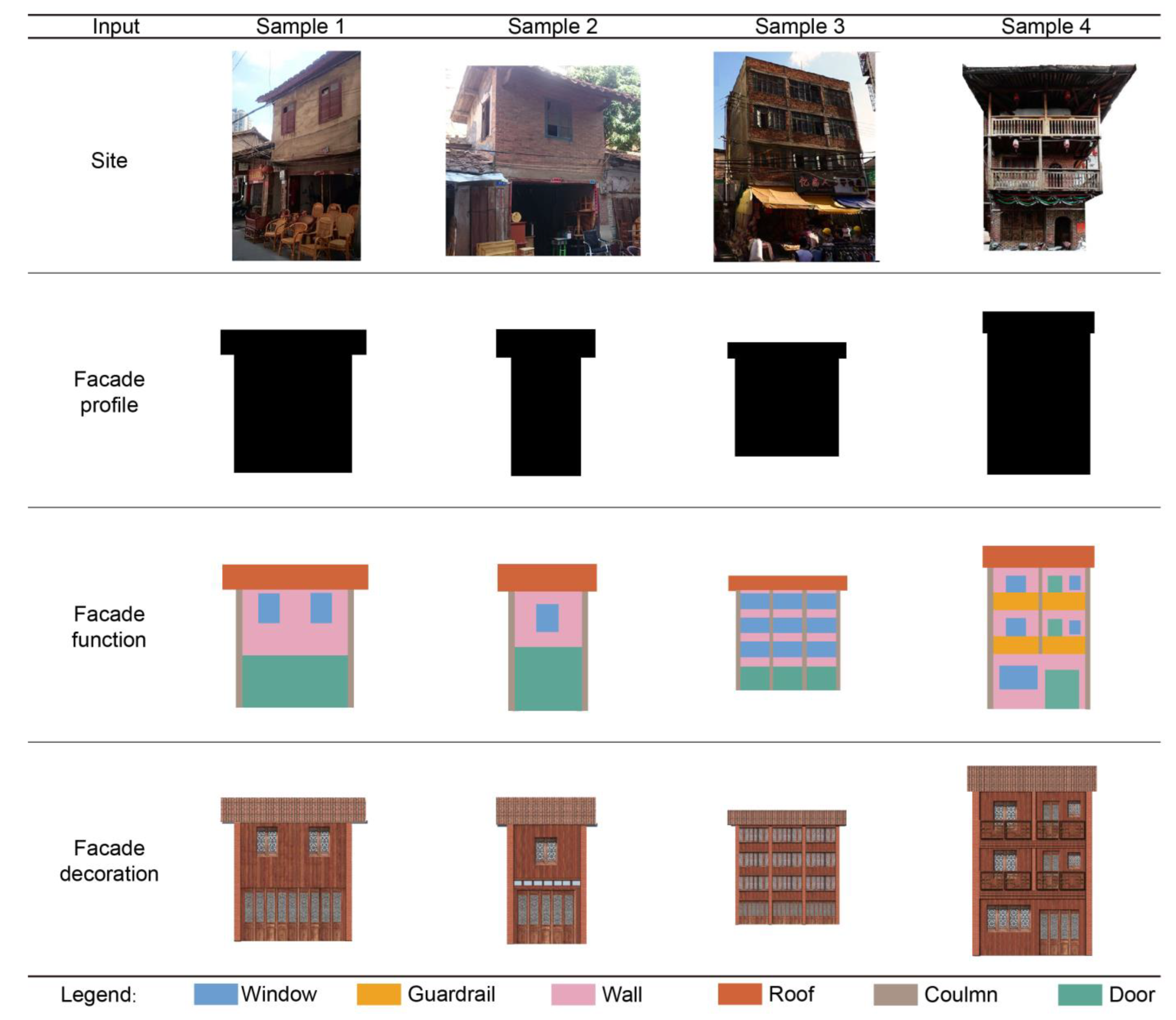


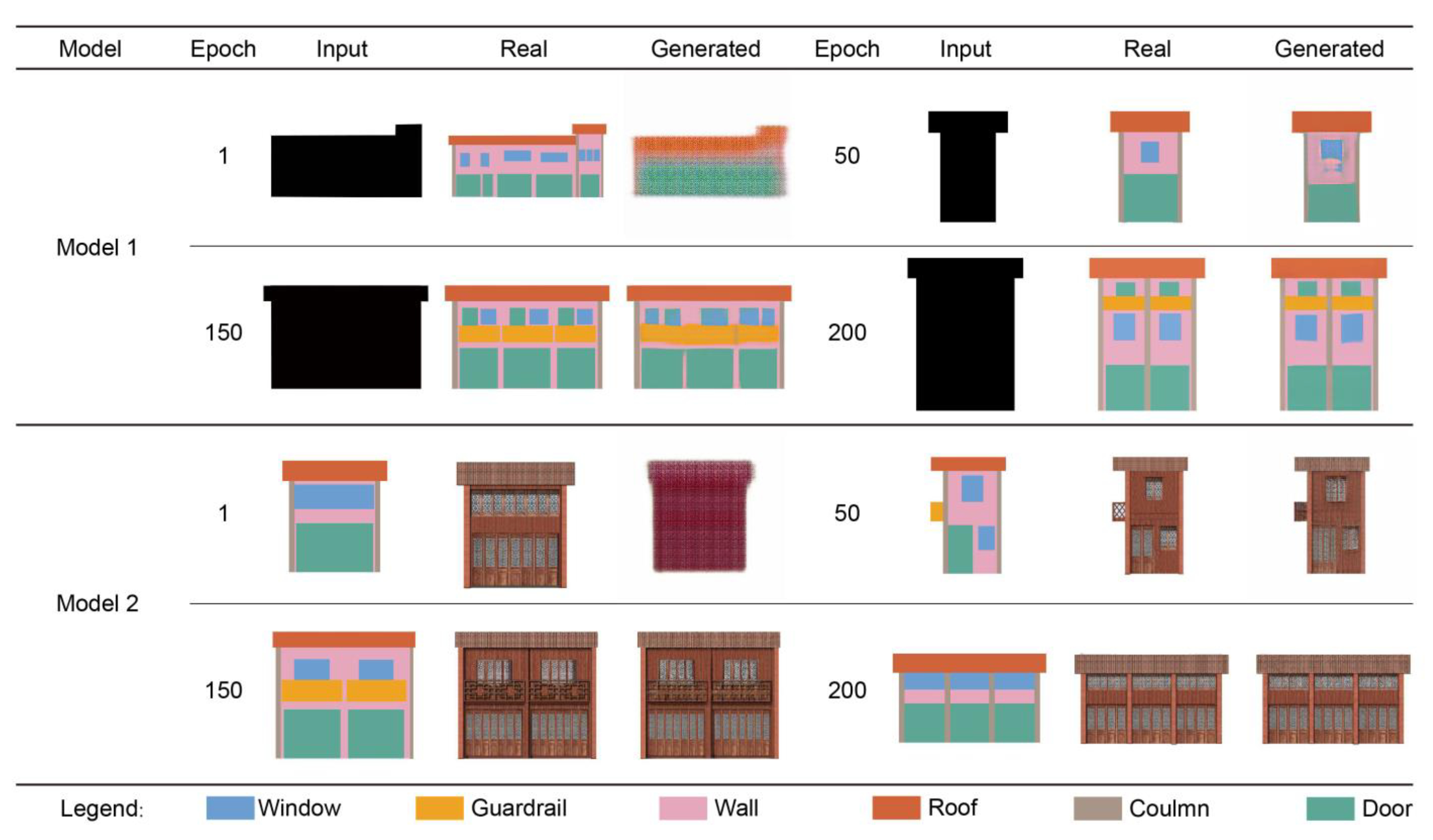
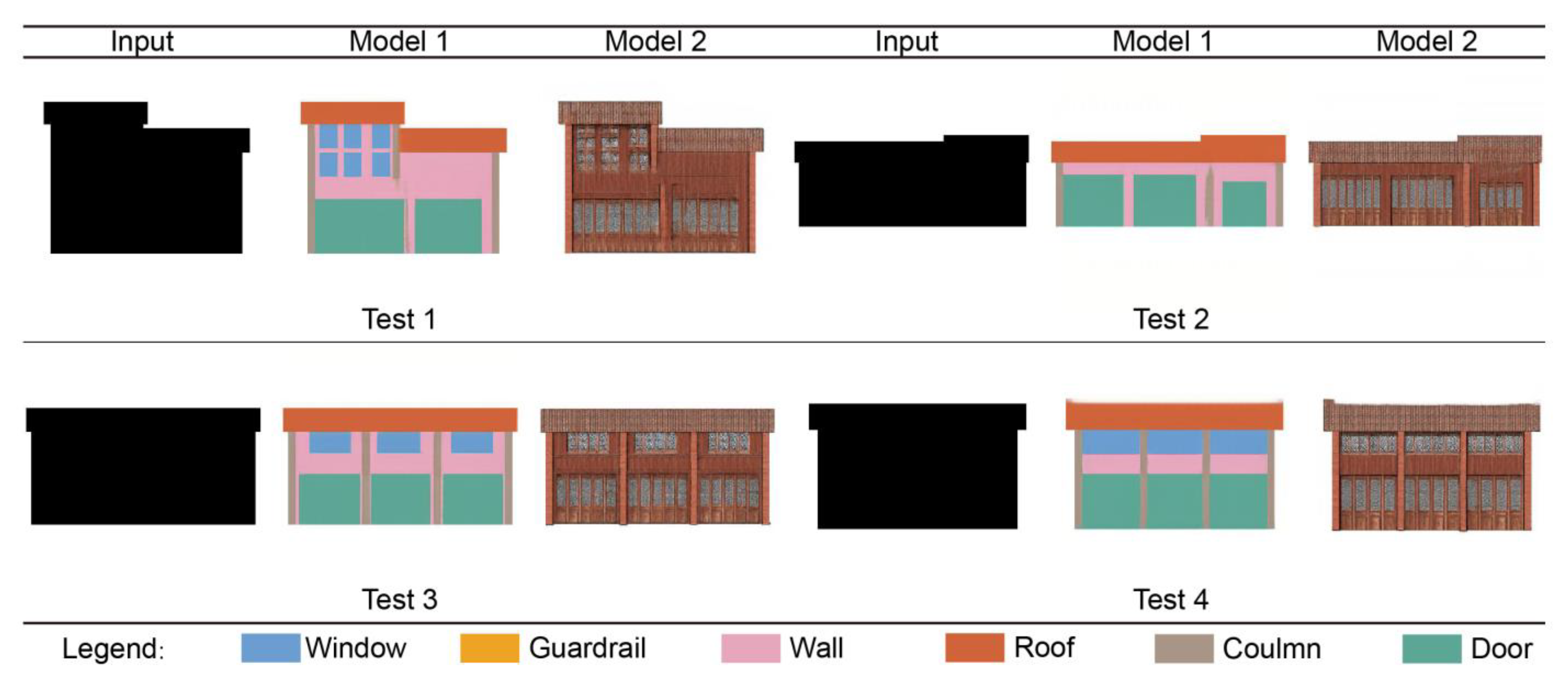

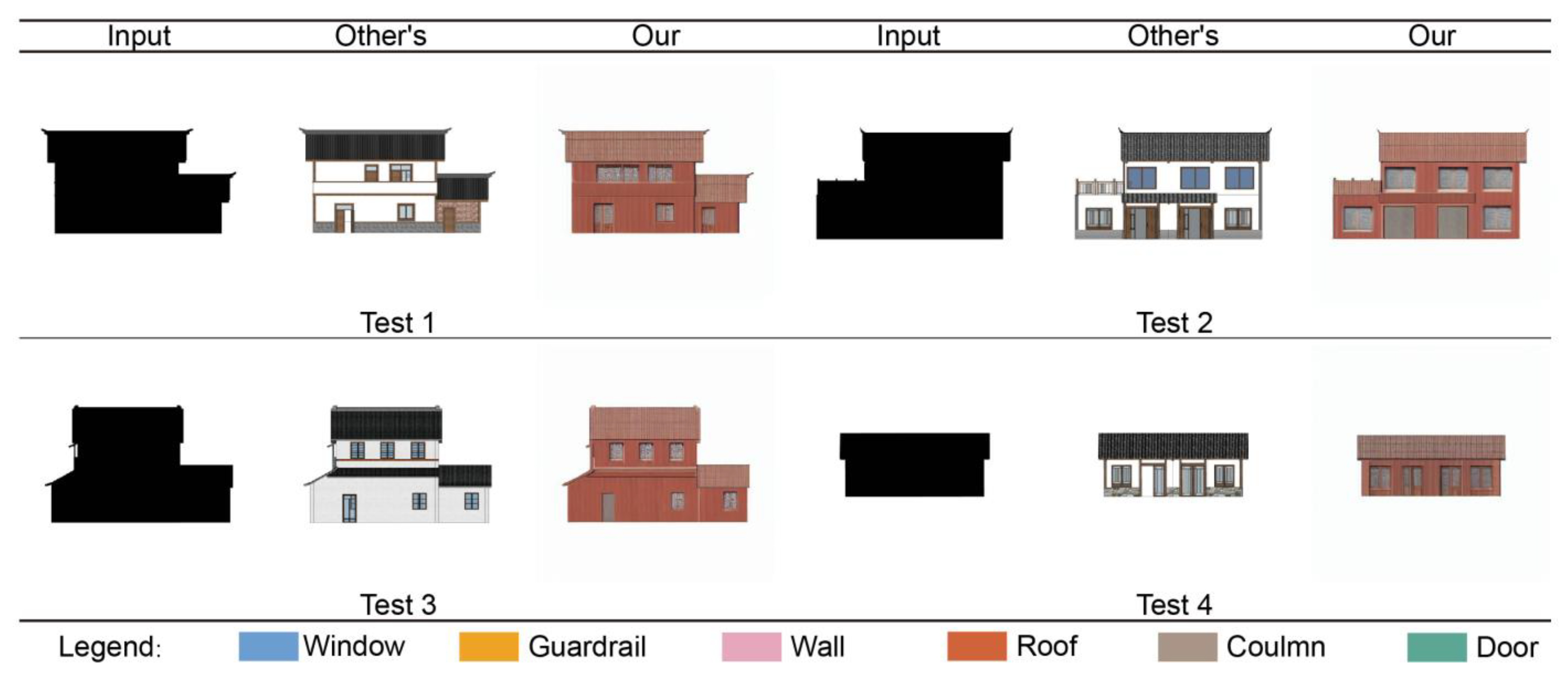

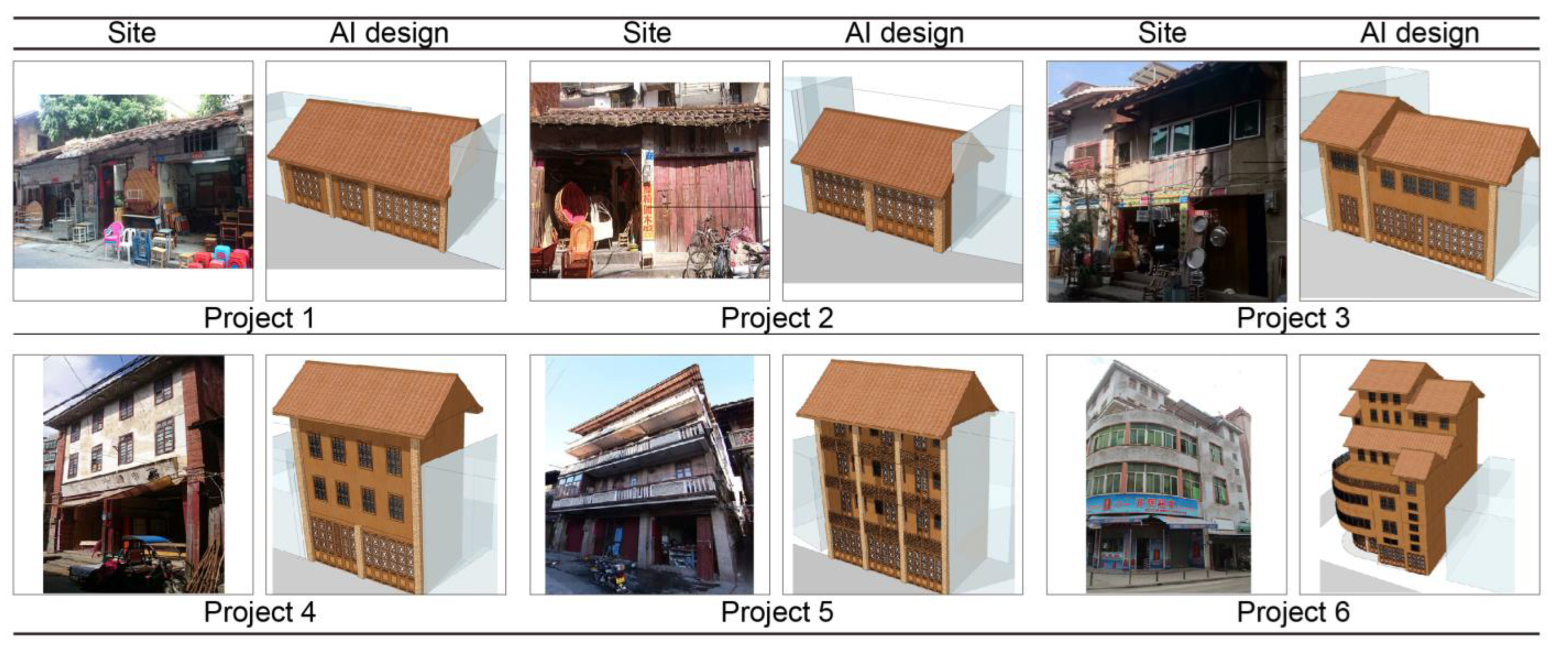
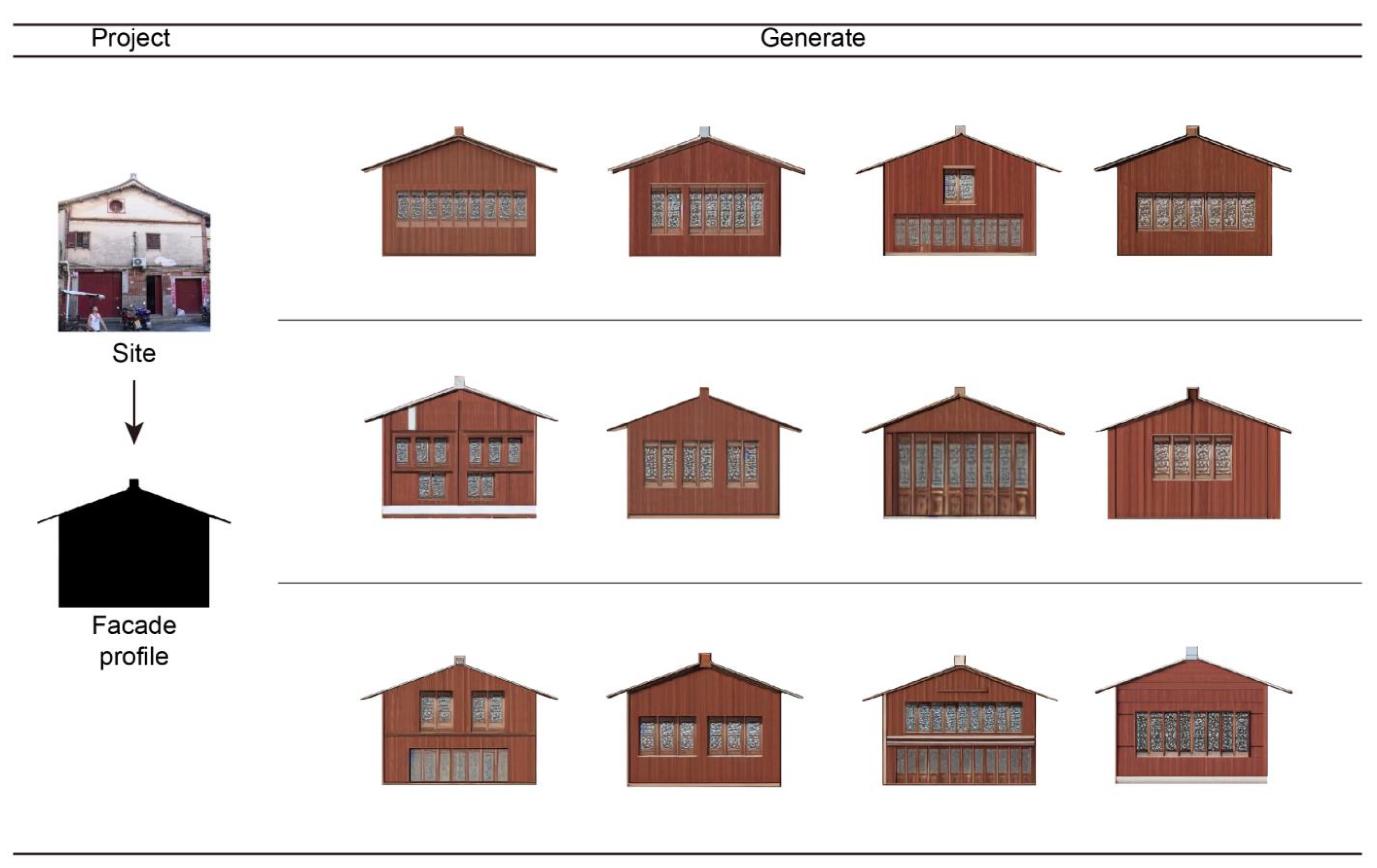
Disclaimer/Publisher’s Note: The statements, opinions and data contained in all publications are solely those of the individual author(s) and contributor(s) and not of MDPI and/or the editor(s). MDPI and/or the editor(s) disclaim responsibility for any injury to people or property resulting from any ideas, methods, instructions or products referred to in the content. |
© 2023 by the authors. Licensee MDPI, Basel, Switzerland. This article is an open access article distributed under the terms and conditions of the Creative Commons Attribution (CC BY) license (https://creativecommons.org/licenses/by/4.0/).
Share and Cite
Lin, H.; Huang, L.; Chen, Y.; Zheng, L.; Huang, M.; Chen, Y. Research on the Application of CGAN in the Design of Historic Building Facades in Urban Renewal—Taking Fujian Putian Historic Districts as an Example. Buildings 2023, 13, 1478. https://doi.org/10.3390/buildings13061478
Lin H, Huang L, Chen Y, Zheng L, Huang M, Chen Y. Research on the Application of CGAN in the Design of Historic Building Facades in Urban Renewal—Taking Fujian Putian Historic Districts as an Example. Buildings. 2023; 13(6):1478. https://doi.org/10.3390/buildings13061478
Chicago/Turabian StyleLin, Hongpan, Linsheng Huang, Yile Chen, Liang Zheng, Minling Huang, and Yashan Chen. 2023. "Research on the Application of CGAN in the Design of Historic Building Facades in Urban Renewal—Taking Fujian Putian Historic Districts as an Example" Buildings 13, no. 6: 1478. https://doi.org/10.3390/buildings13061478
APA StyleLin, H., Huang, L., Chen, Y., Zheng, L., Huang, M., & Chen, Y. (2023). Research on the Application of CGAN in the Design of Historic Building Facades in Urban Renewal—Taking Fujian Putian Historic Districts as an Example. Buildings, 13(6), 1478. https://doi.org/10.3390/buildings13061478








